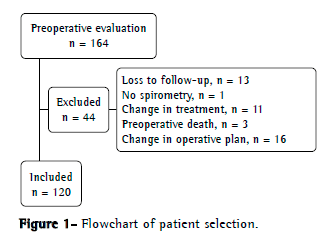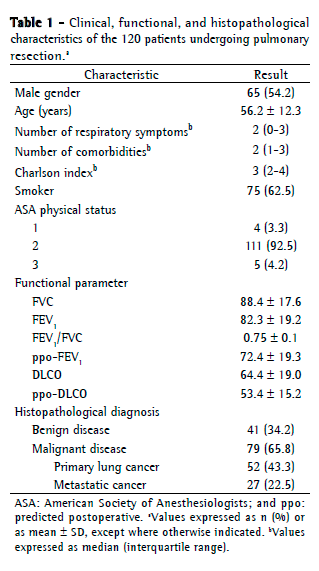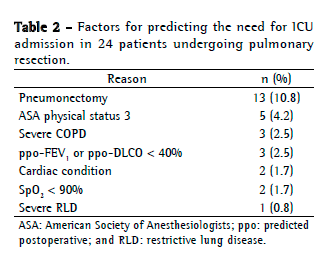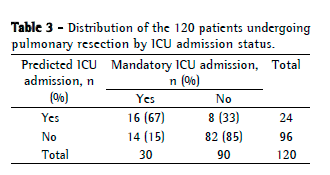



Liana Pinheiro, Ilka Lopes Santoro, João Aléssio Juliano Perfeito, Meyer Izbicki, Roberta Pulcheri Ramos, Sonia Maria Faresin
ABSTRACT
Objective: To determine whether the use of a set of preoperative variables can predict the need for postoperative ICU admission. Methods: This was a prospective observational cohort study of 120 patients undergoing elective pulmonary resection between July of 2009 and April of 2012. Prediction of ICU admission was based on the presence of one or more of the following preoperative characteristics: predicted pneumonectomy; severe/very severe COPD; severe restrictive lung disease; FEV1 or DLCO predicted to be < 40% postoperatively; SpO2 on room air at rest < 90%; need for cardiac monitoring as a precautionary measure; or American Society of Anesthesiologists physical status ≥ 3. The gold standard for mandatory admission to the ICU was based on the presence of one or more of the following postoperative characteristics: maintenance of mechanical ventilation or reintubation; acute respiratory failure or need for noninvasive ventilation; hemodynamic instability or shock; intraoperative or immediate postoperative complications (clinical or surgical); or a recommendation by the anesthesiologist or surgeon to continue treatment in the ICU. Results: Among the 120 patients evaluated, 24 (20.0%) were predicted to require ICU admission, and ICU admission was considered mandatory in 16 (66.6%) of those 24. In contrast, among the 96 patients for whom ICU admission was not predicted, it was required in 14 (14.5%). The use of the criteria for predicting ICU admission showed good accuracy (81.6%), sensitivity of 53.3%, specificity of 91%, positive predictive value of 66.6%, and negative predictive value of 85.4%. Conclusions: The use of preoperative criteria for predicting the need for ICU admission after elective pulmonary resection is feasible and can reduce the number of patients staying in the ICU only for monitoring.
Keywords: Thoracic surgery; Risk factors; Intensive care units.
RESUMO
Objetivo: Avaliar se a utilização de um conjunto de variáveis pré-operatórias é capaz de antever a necessidade de internação em UTI no pós-operatório. Métodos: Estudo de coorte observacio-nal prospectivo, com 120 pacientes submetidos à ressecção pulmonar eletiva entre julho de 2009 e abril de 2012. A previsão de indicação de internação em UTI indicação foi baseada na presença de uma ou mais das seguintes condições pré-operatórias: previsão de pneumonectomia; DPOC grave/muito grave; doença restritiva grave; VEF1 ou DLCO previstos para o pós-operatório < 40% do previsto; SpO2 em repouso e ar ambiente < 90%; necessidade de monitorização cardíaca pro-filática; classificação da American Society of Anesthesiologists ≥ 3. O padrão ouro para internação justificada em UTI foi baseado na presença de uma ou mais das seguintes condições pós-operatórias: manutenção de ventilação mecânica ou reintubação; insuficiência respiratória aguda ou necessidade de ventilação não invasiva; instabilidade hemodinâmica ou choque; intercorrên-cias intraoperatórias ou no pós-operatório imediato (cirúrgicas ou clínicas); indicação do aneste-siologista ou cirurgião para a manutenção de tratamento na UTI. Resultados: Dos 120 pacientes avaliados, houve previsão de necessidade de internação em UTI em 24 (20,0%), sendo essa con-siderada justificada em 16 deles (66,6%) desses 24, ao passo que dos 96 pacientes sem previsão de necessidade de internação em UTI, essa foi necessária em 14 (14,5%). A utilização dos crité-rios preditivos para a internação em UTI mostrou boa acurácia (81,6%), sensibilidade de 53,3%, especificidade de 91%, valor preditivo positivo de 66,6% e valor preditivo negativo de 85,4%. Conclusões: A utilização de critérios pré-operatórios para a indicação de internação em UTI após ressecção pulmonar eletiva é factível e é capaz de reduzir o número de pacientes que aí perma-necem apenas para vigilância
Palavras-chave: Cirurgia torácica; Fatores de risco; Unidades de terapia intensiva.
Introduction




